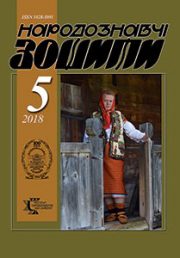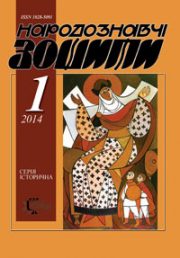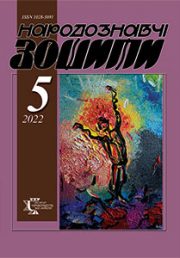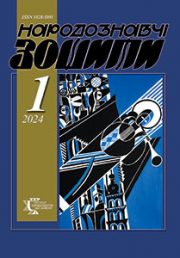The Ethnology Notebooks. 2017, 5 (137), 1168—1172
UDK 391.7:745 (477.85/.87) “187/195”
DOI https://doi.org/10.15407/nz2017.05.1168
BREAST JEWELRY OF HUTSULSHCHYNA IN THE CONTEXT OF PRESERVATION AND DEVELOPMENT OF FOLK TRADITIONS
Frank Ivan Mykolaiovych, Head of the Department of Metal Art
at the Lviv National Academy of Arts,
Kubiiovycha Str., 38, Lviv, 79011, Ukraine.
Contacts: Tel. (032) 2761482; e-mail: office@lnam.edu.ua
Abstract. Formation and development of traditions of producing and decoration of breast jewelry of hutsuls are tracing; modifications of traditional ethnic cultural phenomena connected with social changes in society are detecting; appearance of new ethnic cultural qualities on the basis of modern social and cultural changes is investigating. There has been made a try to trace stages of history of the main and auxiliary components of breast jewelry due to preservation and multiplication of folk traditions; both the development of decorative art at Hutsulshchyna is traced.
Keywords: function, breast, jewelry, folk tradition.
Received 25.07.2017
REFERENCES
Arsenych, P.I., Bazyk, M.I. & Boltarovych, Z.Ye. (1987). Hutsul’schyna. Kyiv : Naukova dumka [in Ukrainian].
Bon’kovs’ka, S. (2001). Hutsul’s’ke mosiazhnytstvo i problemy joho rozvytku. Istoriia Hutsul’schyny (Vol. 6). L’viv : Lohos [in Ukrainian].
Bon’kovs’ka, S. (1992). Khudozhni tradytsii hutsul’s’koho mosiazhnytstva. Zapysky NTSh im. T. Shevchenka, 223 [in Ukrainian].
Bon’kovs’ka, S. (2006). Khudozhnij metal. In Pavliuk S. (Ed.), Etnohenez ta etnichna istoriia naselennia Ukrains’kykh Karpat (Vol. 2). L’viv [in Ukrainian].
Vrochyns’ka, H. (2007). Ukrains’ki narodni zhinochi prykrasy XIX — pochatku XX stolit’. Kyiv : Rodovid [in Ukrainian].
Hoberman, D.N. (1980). Iskusstvo hutsulov. Moskva : Sovetskyj khudozhnyk [in Russian].
Zholtovs’kyj, P. (1972). Khudozhnij metal. Kyiv : Mystetstvo [in Ukrainian].
Sukha, L.M. (1959). Khudozhni metalevi vyroby ukraintsiv Skhidnykh Karpat druhoi polovyny XIX — XX st. Kyiv [in Ukrainian].
Shukhevych, V. (1901). Hutsul’schyna (Ch. 2). Materyialy do ukrains’korus’koi etnol’ogii, 4, 145—320 [in Ukrainian].







